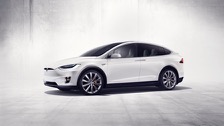Product Description
Home and Destination Charging (0 -> 100%)
Charging is possible by using a regular wall plug or a charging station. Public charging is always done through a charging station. How fast the EV can charge depends on the charging station (EVSE) used and the maximum charging capacity of the EV. The table below shows all possible options for charging the Tesla Model X Dual Motor. Each option shows how fast the battery can be charged from empty to full.
Europe
Charging an EV in Europe differs by country. Some European countries primarily use 1-phase connections to the grid, while other countries are almost exclusively using a 3-phase connection. The table below shows all possible ways the Tesla Model X Dual Motor can be charged, but some modes of charging might not be widely available in certain countries.
| Type 2 (Mennekes – IEC 62196) |
|---|
 |
| Charging Point | Max. Power | Power | Time | Rate |
|---|---|---|---|---|
| Wall Plug (2.3 kW) | 230V / 1x10A | 2.3 kW | 48h45m | 10 km/h |
| 1-phase 16A (3.7 kW) | 230V / 1x16A | 3.7 kW | 30h15m | 16 km/h |
| 1-phase 32A (7.4 kW) | 230V / 1x32A | 7.4 kW | 15h15m | 31 km/h |
| 3-phase 16A (11 kW) | 400V / 3x16A | 11 kW | 10h15m | 46 km/h |
| 3-phase 32A (22 kW) | 400V / 3x16A | 11 kW † | 10h15m | 46 km/h |
† = Limited by on-board charger, vehicle cannot charge faster.
(Advertisement)
Fast Charging (10 -> 80%)
Rapid charging enables longer journeys by adding as much range as possible in the shortest amount of time. Charging power will decrease significantly after 80% state-of-charge has been reached. A typical rapid charge therefore rarely exceeds 80% SoC. The rapid charge rate of an EV depends on the charger used and the maximum charging power the EV can handle. The table below shows all details for rapid charging the Tesla Model X Dual Motor.
Tesla has not released details about rapid charging the Model X. The information below is based on estimated values of the most likely rapid charging capabilities.
- Max. Power: maximum power provided by charge point
- Avg. Power: average power provided by charge point over a session from 10% to 80%
- Time: time needed to charge from 10% to 80%
- Rate: average charging speed over a session from 10% to 80%
| Combined Charging System (CCS Combo 2) |
|---|
 |
| Charging Point | Max. Power | Avg. Power | Time | Rate |
|---|---|---|---|---|
| CCS (50 kW DC) | 50 kW | 50 kW | 84 min | 230 km/h |
| Supercharger v2 Shared (75 kW DC) | 75 kW | 70 kW † | 60 min | 330 km/h |
| Supercharger v2 (150 kW DC) | 150 kW | 110 kW † | 38 min | 520 km/h |
| CCS (175 kW DC) | 175 kW | 120 kW † | 35 min | 570 km/h |
| Supercharger v3 (250 kW DC) | 250 kW | 140 kW † | 30 min | 660 km/h |
| CCS (350 kW DC) | 250 kW † | 140 kW † | 30 min | 660 km/h |
| This vehicle supports Autocharge |
|---|
| This vehicle does not support Plug & Charge |
† = Limited by charging capabilities of vehicle
Autocharge: allows for automatic initiation of a charging session at supported CCS charging stations.
Plug & Charge: allows for automatic initiation of a charging session at supported CCS charging stations in accordance with ISO 15118.
Actual charging rates may differ from data shown due to factors like outside temperature, state of the battery and driving style.
Preceding model
The model shown on this page is the successor of the Tesla Model X Long Range Plus, which was available to order from November 2020 until March 2021.
The previous model had 5 km more range, 18% slower acceleration and was similar in energy consumption.
 Preceding model Tesla Model X Long Range Plus
Preceding model Tesla Model X Long Range Plus















